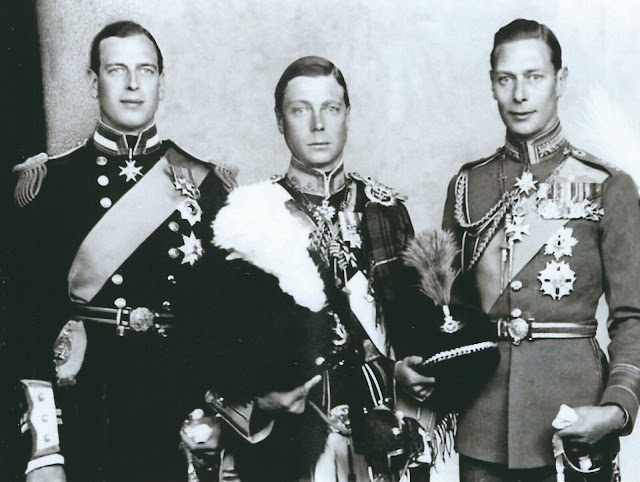Two contemporaneous Press photographs demonstrate quite how long and hard a struggle was the Very British Civil War:
 |
The King's Colonials marching off to war - with bayonets fixed.
Obviously an early VBCW photograph, with Edward VIII looking relaxed and confident
and Commandant Stokkies Joubert (leading in salute) remarkably athletic
(even when in his riding breeches - and vertical). |
 |
Later in the VBCW - a careworn Edward VIII inspecting a section of the notorious
"Goering Leibwachter", the Reichsmarschall's hand-picked and
black uniformed bodyguard, Herefordshire 1938. |
Commandant Stokkies Joubert led the "Kings Colonials" aggressively and successfully during the early stage of the Hereford VBCW, particularly featuring in the Battles of Second Ledbury and Marcle Ridge. Nevertheless, he was captured by the Bishop of Ludlow at the Battle of Winforton Pontoons, with the much-reduced (by casualties and desertion) and otherwise entirely ungovernable "Kings Colonials" thereafter becoming dispersed, awaiting Joubert's release or escape. For more on Stokkies Joubert, see HERE.
Reichsmarschall Hermann Goering, accompanied by two full Sections of elite Fallschirmjager, surprised everyone (including the Fuhrer) by "dropping in" to the Hereford VBCW at the Battle of Mortimer's Cross. After that battle, from which the Fallschirmjager emerged victorious but heavily depleted in numbers, the Reichsmarschall established his "Command Headquarters" at the Castle Hotel, Hereford and his Fallschirmjager's "Battle Headquarters" at The Black Lion, Bridge Street. Contemporaneous gossip noted that the two were conveniently situated within easy walking distance. Later in the VBCW, the Reichsmarschall's forces were supplemented by enthusiastic "European tourists", "lost airmen" and other such volunteers. The best (and most physically imposing) of these were mustered into the "Goering Leibwachter", which never exceeded section strength. For more on Goering, see HERE.
Notes :
(1). "Real world" historians have expressly noted that the caption on the reverse of the top photograph states "The New King. 21.1.36. The Prince of Wales taking the salute of Australian troops outside Australia House, during the Peace Day Procession in 1919". While it is the case that George V died on 20th January 1936, and there was a Peace Day Procession on 19th July 1919, the photograph is clearly of The Strand in London (the church in the background, St Mary-le-Strand, is unmistakable), while Australia House (officially opened 3rd August 1918) was (and remains to this day) in Trafalgar Square. As the King's purpose built dias is demonstrably outside Somerset House in the Strand (conveniently close to The Savoy Grill), VBCW historians have been emboldened to denounce the first caption as "a crude fake" and claim both photographs (the second uncaptioned) for their own time/dimension.
(2). Goering's "volunteers" were brigaded together under various other titles, including a tactful resurrection of the "King's German Legion" (disbanded at the end of the Napoleonic Wars) and lesser known "Hanoverian Legion", both uniformed in WW1 German grey green and Stahlhelm, but armed with a mixture of Mausers, Lee Enfields, Bergmans and Lewis Guns. At least one artillery piece seems to have been crewed by recruits from the little known SA Artillerie-Ausbildungsschule.
(3). For the history and uniforms of both the "King's Colonials" and Reichsmarschall Goering's volunteer units, see "Foreign Volunteers in the Very British Civil War (3) - Specialist Infantry and Artillery" (Osprey, 2011), both generally in the text and particularly uniform Plates C and E. Note that these illustrations are now seen as somewhat outdated, particularly in relation to key details such as bayonet frogs and the omission of "five button fly battle trousers" - a significant technical advance at the time (see "Logistical Relief in the VBCW - The Five Button Fly", unpublished PHD, "Oxford Brookes University", 2021). A flavour of the Germanic volunteers' VBCW experience can be gained from Jabo's "Gott im Himmel ! Hereford !" (1967 - published in paperback in the USA as "Krauts in the Kingdom"), albeit the author's extensive medal claims (some alleged, somewhat curiously, to be posthumous) are heavily disputed.





W,QumuBORD9R5mww~~0_12.jpg)
















.JPG)


.JPG)













.jpg)


.jpg)





